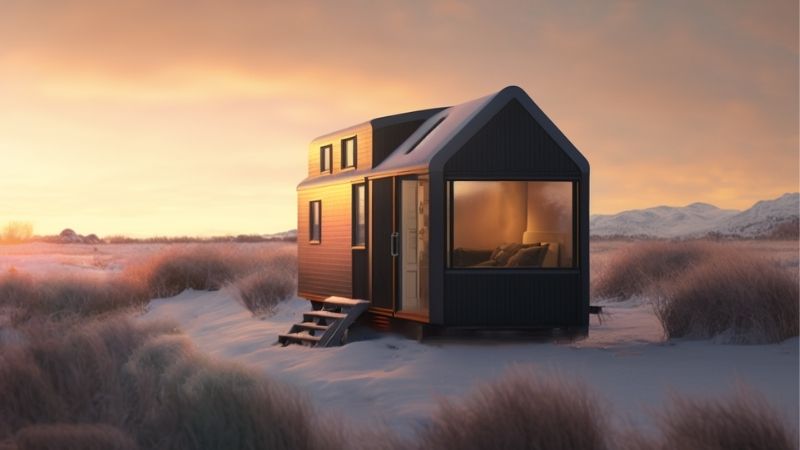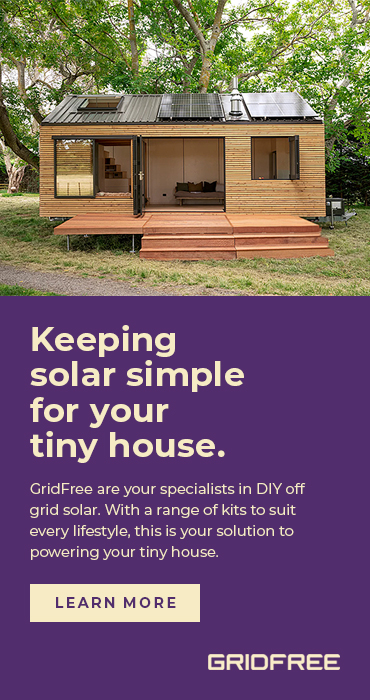Even though most of New Zealand doesn’t experience the extreme winters that people in other parts of the world have to deal with, it’s still a good idea to do some basic winter prep to ensure you and your tiny house are ready for the colder season. Here are four things you want to consider now to make sure winter in your tiny house will be enjoyable.
Keeping warm
Even if you’re based in the so-called winterless north, chances are there will be some days when it will be freezing in your tiny without heating. And if you’re further south, then reliable heating is a no-brainer. Depending on your setup, you have several options. If you’re on the grid, you can heat your tiny home like you would a normal house with a heat pump or electric heater. On the other hand, if you’re off-grid, you will need a heating source that requires no or very little power. Wood fires are a popular option. However, if you don’t have one installed yet, it’s unlikely you will get it done in time for winter. Luckily, there are other options. For example, a diesel heater is generally easier to install than a fireplace. Electric blankets could also be an option, as they require relatively small amounts of power. In addition, thermal curtains are a great way to keep the heat you have inside and the cold outside.
If you choose a heating option that requires some kind of fuel, like a wood fire or diesel heater, stock up before winter, so you don’t run out in the middle of the coldest week of the year. Also, if you have a fireplace, now is the time to clean the firebox and flue.
It’s also a good idea to do a test run of your heating source now, even if you don’t technically need it yet. That way, you can identify any issues while you still have time to fix them.
Keeping dry
Keeping warm is probably the first thing people think about when preparing for winter. However, as many seasoned tiny house dwellers will tell you, dampness is actually your number one enemy, not the cold.
The combination of small spaces and people usually results in dampness. Just by breathing, cooking, showering and going about our lives, we add moisture to the air. In winter, we tend to get more rain which adds humidity and results in us bringing in wet gear into the tiny. It’s also cold, so we tend to keep doors and windows closed, which means all that damp air is locked inside.
In a big house, that humid air spreads out, but in a tiny house, it doesn’t have anywhere to go. And it’s sneaky. You might not think your tiny home is particularly damp – until you find the summer clothes stored in the back of your closet have gone mouldy over winter. How do you avoid this happening? Sorting out heating is step one. Step two is airing out your tiny house regularly. Whenever it’s sunny in winter, your doors and windows should be open for a while.
Be extra vigilant about keeping shower steam in the bathroom, ideally in the shower itself with a shower dome. Running a dehumidifier daily in different parts of the house is also a good idea, and get into a habit of towelling off any windows with condensation on the cold mornings.
Also, be aware of spots most likely to get damp and check them regularly. If your mattress is on or close to the ground, check and air it regularly, and check the back of the closet and behind furniture that’s backing right onto a wall.
If you find your tiny house gets very damp over winter despite these efforts, you might want to look into installing a proper ventilation system before the next winter. Many professional builders now recommend them as a default for new builds, as they have proven to make a big difference when it comes to managing dampness in a tiny home.
Keeping the batteries charged
If you’re off-grid, the third biggest winter challenge after heating and keeping dampness at bay will probably be having enough power to keep the lights on (and everything else running). Not only are the days shorter in winter, but we also tend to get less sunshine, and the sun we do get is less intense. All this results in much less power generated by your solar system.
There are a few things you can do to maximise the output of your solar system. Start by running a complete check of your batteries and system now so you know of any potential issues before they can significantly impact you. If your batteries are nearing the end of their life, you might want to swap them out now, or at least be confident that you can get new batteries quickly when needed.
Next, give your solar panels a good clean, and do so at least once a month over winter. You might also want to adjust the position of your solar panels to make sure they get maximum exposure to the winter sun.
If you’re worried that all of this won’t be enough to keep the batteries charged over winter, look at investing in a backup generator to use when it rains for days or while running the washing machine or other high-power equipment.
Keeping dirt and moisture outside
Tiny houses are easy to clean. But they also tend to get dirty quickly. When it’s wet outside in winter, all it takes is two people walking in and out with dirty shoes a few times and bringing in some wet and muddy gear to make your otherwise tidy tiny look messy. Not to mention that all this wet and dirty gear adds to the dampness in the tiny.
If you can, create a covered area in front of your door where you can take off, and ideally leave, dirty shoes and jackets. If you have to bring them inside, have a mat right by the door and make it a point to remove any wet gear before you go any further into the house.
You might also want to think about your access way. Walking over grass to get from your car to the house might not be an issue in summer, but that grassy area can quickly become a mud pit in winter. Consider putting down some gravel or outdoor tiles to create a weatherproof path – just make sure it doesn’t become slippery when wet.
If you prepare for the cold and damp season now, there'll be nothing to get in the way of enjoying winter in your tiny house. Stay warm, stay dry, keep the lights on, the dirt outside, and snuggle up with a hot cuppa and a good book - that’s winter bliss.


